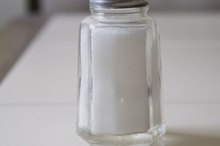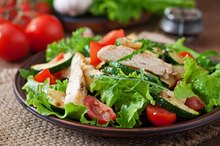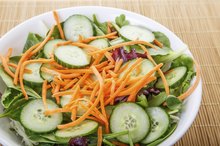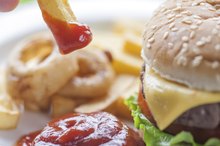What does fact checked mean?
At Healthfully, we strive to deliver objective content that is accurate and up-to-date. Our team periodically reviews articles in order to ensure content quality. The sources cited below consist of evidence from peer-reviewed journals, prominent medical organizations, academic associations, and government data.
- Centers for Disease Control and Prevention: U.S. Obesity Trends
- MedlinePlus: Coronary Artery Disease
The information contained on this site is for informational purposes only, and should not be used as a substitute for the advice of a professional health care provider. Please check with the appropriate physician regarding health questions and concerns. Although we strive to deliver accurate and up-to-date information, no guarantee to that effect is made.
What Is the Prudent Diet?
The Centers for Disease Control and Prevention (CDC) reports that heart disease is the No. 1 cause of death in the United States in both men and women; in 2008, at least 25 percent of adults in most states were obese. In a society of plentiful food and obesity on the rise, the fight on heart disease flourishes. The prudent diet is necessary to dampen this artery-clogging disease.
Function
MedlinePlus reports heart disease includes coronary artery disease, which may occur from the accumulation of a fatty substance in the artery wall, causing a blockage 1. All individuals with a diagnosis of heart disease or who have a family history of heart disease should follow a prudent diet. The diet is low in total fat, saturated fat, trans fat, cholesterol and sodium. These dietary modifications assist in lowering cholesterol and triglyceride blood levels and blood pressure.
- MedlinePlus reports heart disease includes coronary artery disease, which may occur from the accumulation of a fatty substance in the artery wall, causing a blockage 1.
Features
A Low-Salt, Low-Fat & Low-Cholesterol Diet
Learn More
The U.S. Food and Drug Administration reports that a food item is considered low-fat when there is it contains 3 g or less of total fat per serving. A meal is low-fat when there are 3 g or less total fat per 100 g serving and 30 percent or less fewer calories are from fat. Low saturated fat guidelines allow for 1 g or less per serving and no more than 15 percent of calories. Low cholesterol signifies 20 mg or less cholesterol and 2 g or less saturated fat per serving. Low sodium is recognized as 140 mg or less per serving.
- The U.S. Food and Drug Administration reports that a food item is considered low-fat when there is it contains 3 g or less of total fat per serving.
- Low saturated fat guidelines allow for 1 g or less per serving and no more than 15 percent of calories.
Food Items
All animal products contain saturated fat and cholesterol. Animal products include:
- red meat
- poultry
- pork
- fish
- eggs
- dairy
Choose the lower fat and cholesterol options. Cheese is high in sodium. Prepackaged foods tend to be higher in trans fats and sodium. Read food labels carefully, and remember variety and moderation of foods.
- All animal products contain saturated fat and cholesterol.
Benefits
The Best Foods for Edema
Learn More
Sodium reduction as been shown to lower blood pressure and the risk for heart disease. According to a study in the May 2009 issue of the "American Journal of Clinical Nutrition," reducing saturated fat and replacing it with polyunsaturated fats found in some vegetable oils, fatty fish, nuts and seeds prevents coronary heart disease in middle aged and older adults 1. Soluble fiber in fruits, vegetables, legumes, oats and barley decrease cholesterol in the blood.
Misconceptions
A person with diabetes can follow the prudent diet. Choose foods low in fat, cholesterol and sodium at meals and snacks and continue counting carbohydrates. Prudent diets are not bland and tasteless when herbs, spices, vinegar and low-fat or low-sodium sauces are added. Fruits and vegetables make delectable salsas and sauces to add to meals and snacks. There are a variety of tasteful foods allowed on the prudent diet, so an individual will not starve.
- A person with diabetes can follow the prudent diet.
- Choose foods low in fat, cholesterol and sodium at meals and snacks and continue counting carbohydrates.
Related Articles
References
- MedlinePlus: Coronary Artery Disease
- Control Your Cholesterol. American Heart Association. April 30, 2017
- Goldstein JL, Brown MS. A Century of Cholesterol and Coronaries: From Plaques to Genes to Statins. Cell. 2015;161(1):161-172. doi:10.1016/j.cell.2015.01.036
- Fernandez M. Rethinking dietary cholesterol. Curr Opin Clin Nutr Metab Care. 2012;15(2):117-121. doi:10.1097/mco.0b013e32834d2259
- Blesso CN, Andersen CJ, Barona J, Volek JS, Fernandez ML. Whole egg consumption improves lipoprotein profiles and insulin sensitivity to a greater extent than yolk-free egg substitute in individuals with metabolic syndrome. Metab Clin Exp. 2013;62(3):400-10. doi:10.1016/j.metabol.2012.08.014
- Jones PJH. Dietary cholesterol and the risk of cardiovascular disease in patients: a review of the Harvard Egg Study and other data. International journal of clinical practice Supplement. 2009;(163):1-8, 28-36. doi:10.1111/j.1742-1241.2009.02136.x
- Sabaté J, Oda K, Ros E. Nut Consumption and Blood Lipid Levels: A Pooled Analysis of 25 Intervention Trials. Arch Intern Med. 2010;170(9):821–827. doi:10.1001/archinternmed.2010.79
- Beynen AC, Katan MB, Van zutphen LF. Hypo- and hyperresponders: individual differences in the response of serum cholesterol concentration to changes in diet. Adv Lipid Res. 1987;22:115-71. doi:10.1016/b978-0-12-024922-0.50008-4
- Cholesterol Management Guide for Healthcare Providers. American Heart Association. 2018
- Nathalie Bergeron, Sally Chiu, Paul T Williams, Sarah M King, Ronald M Krauss, Effects of red meat, white meat, and nonmeat protein sources on atherogenic lipoprotein measures in the context of low compared with high saturated fat intake: a randomized controlled trial, The American Journal of Clinical Nutrition, Volume 110, Issue 1, July 2019, Pages 24–33, doi:10.1093/ajcn/nqz035
- Ramsden CE, Zamora D, Majchrzak-Hong S, et al. Re-evaluation of the traditional diet-heart hypothesis: analysis of recovered data from Minnesota Coronary Experiment (1968-73). BMJ. April 2016:i1246. doi:10.1136/bmj.i1246
- Xin-Xin Zheng, Yan-Lu Xu, Shao-Hua Li, Xu-Xia Liu, Rutai Hui, Xiao-Hong Huang, Green tea intake lowers fasting serum total and LDL cholesterol in adults: a meta-analysis of 14 randomized controlled trials, The American Journal of Clinical Nutrition, Volume 94, Issue 2, August 2011, Pages 601–610, doi:10.3945/ajcn.110.010926
- Chen HJ, Chuang SY, Chang HY, Pan WH. Energy intake at different times of the day: Its association with elevated total and LDL cholesterol levels. Nutr Metab Cardiovasc Dis. 2019;29(4):390-397. doi:10.1016/j.numecd.2019.01.003
- Yashin A, Yashin Y, Xia X, Nemzer B. Antioxidant Activity of Spices and Their Impact on Human Health: A Review. Antioxidants (Basel). 2017;6(3):70. Published 2017 Sep 15. doi:10.3390/antiox6030070
- Pedersen TR. The Success Story of LDL Cholesterol Lowering. Circ Res. 2016;118(4):721-31.doi:https://doi.org/10.1161/CIRCRESAHA.115.306297
- Di Stasi SL, MacLeod TD, Winters JD, Binder-Macleod SA. Effects of statins on skeletal muscle: a perspective for physical therapists. Phys Ther. 2010;90(10):1530–1542. doi:10.2522/ptj.20090251
- Fernandez M. Rethinking dietary cholesterol. Curr Opin Clin Nutr Metab Care. 2012;15(2):117-121. doi:10.1097/mco.0b013e32834d2259
- Goldstein JL, Brown MS. A Century of Cholesterol and Coronaries: From Plaques to Genes to Statins. Cell. 2015;161(1):161-172. doi:10.1016/j.cell.2015.01.036
- Harvard School of Public Health. Cholesterol. The Nutrition Source. Published May 22, 2019.
- Ha V, Sievenpiper JL, de Souza RJ, et al. Effect of dietary pulse intake on established therapeutic lipid targets for cardiovascular risk reduction: a systematic review and meta-analysis of randomized controlled trials. Canadian Medical Association Journal. 2014;186(8):E252-E262. doi:10.1503/cmaj.131727
- Jones P, Pappu A, Hatcher L, Li Z, Illingworth D, Connor W. Dietary Cholesterol Feeding Suppresses Human Cholesterol Synthesis Measured by Deuterium Incorporation and Urinary Mevalonic Acid Levels. Arterioscler Thromb Vasc Biol. 1996;16(10):1222-1228. doi:10.1161/01.atv.16.10.1222
- Magriplis E, Sialvera TE, Papadopoulou A, et al. Effectiveness and easiness of adherence to behavioural guidelines for diet and lifestyle changes for cholesterol-lowering: the Increasing Adherence of Consumers to Diet & Lifestyle Changes to Lower (LDL) Cholesterol (ACT) randomised controlled trial. J Hum Nutr Diet. 2019;32(5):607-618. doi:10.1111/jhn.12667
- Maugeri A, Kunzova S, Medina-Inojosa JR, et al. Association between eating time interval and frequency with ideal cardiovascular health: Results from a random sample Czech urban population. Nutrition, Metabolism and Cardiovascular Diseases. 2018;28(8):847-855. doi:10.1016/j.numecd.2018.04.002
- Olsson AG, Angelin B, Assmann G, et al. Can LDL cholesterol be too low? Possible risks of extremely low levels. Journal of Internal Medicine. 2017;281(6):534-553. doi:10.1111/joim.12614
- Rosenthal RL. Effectiveness of altering serum cholesterol levels without drugs. Proc (Bayl Univ Med Cent). 2000;13(4):351–355. doi:10.1080/08998280.2000.11927704
- Swift D, Johannsen N, Lavie C, Earnest C, Church T. The Role of Exercise and Physical Activity in Weight Loss and Maintenance. Prog Cardiovasc Dis. 2014;56(4):441-447. doi:10.1016/j.pcad.2013.09.012
Resources
Writer Bio
Amy Fanjoy began writing nutrition articles in 2008. She is a registered and licensed dietitian, and her articles have been used for marketing purposes and published in "Yadkin Valley Living" magazine. She earned a Master of Science in human nutrition from the University of North Carolina at Greensboro.









